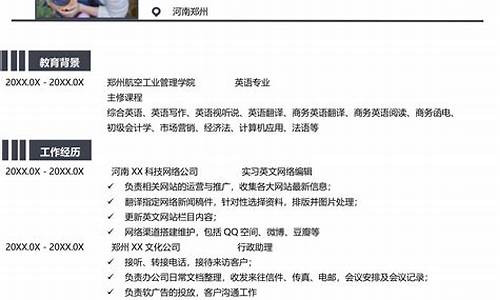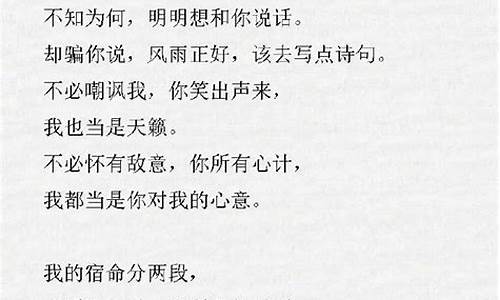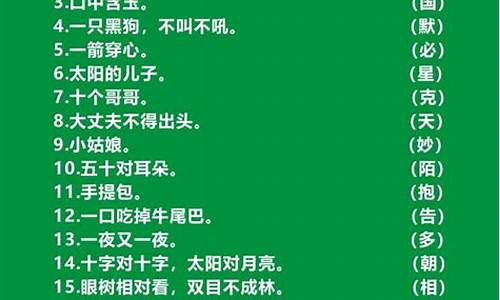您现在的位置是: 首页 > 话题作文 话题作文
七年级上册英语教材_goforit七年级上册英语教材
zmhk 2024-05-30 人已围观
简介七年级上册英语教材_goforit七年级上册英语教材 希望我能够为您提供一些与七年级上册英语教材相关的信息和建议。如果您有任何疑问或需要更深入的解释,
希望我能够为您提供一些与七年级上册英语教材相关的信息和建议。如果您有任何疑问或需要更深入的解释,请告诉我。
1.人教版七年级上册英语Unit7教案

人教版七年级上册英语Unit7教案
英语教案设计是数学课堂教学活动的一个重要组成部分,是教师钻研教材的结晶。为此,下面就不妨和我一起来了解下2017年人教版七年级上册英语Unit 7教案,希望对各位有帮助!
2017年人教版七年级上册英语Unit 7教案
一、教师寄语:
Believe yourselves, your world is more beautiful.
二、教学目标:
1、知识目标:
词汇(1)表示衣服的:pants,sock,shirt,shorts,sweater,shoe, skirt
(2)表示颜色的:color, black, white, red, green, blue, yellow
(3)表示形状的:big, small, short, long
交际用语:
(1)?How much is this T-shirt It's seven dollars.
(2)?How much are these socks They're two dollars.
2、能力目标:学会询问价格及购物用语..
3、情感目标:通过购物的礼貌用语培养学生的良好品质。
三、教学重、难点:
学会使用询问价格的句型,并能正确回答
四、教学过程:
Step1 预习并尝试性探究:
根据汉语写出下列英语词语并展示.
美元____________(价钱)多少_______________ 红色的毛衣______________
黑色的衬衫_____________ 白色的裙子____________**的短裤裤_____________
长的裤子_____________ 短的袜子________________大的鞋子________________
小帽子______________
Step2: 自主学习:
1.自读1a单词, 然后将单词与图中物品相搭配..
2.小组核对答案.
3.自读1c对话、理解意思,并两人一组练习对话.
4.两人一组展示对话,小组竞争.
5.活学活用,利用身边的实物,两人一组练习对话.
Step3: 合作探究:
1. 师生合作完成听力练习
1) 听录音,完成1b, 2a 以及2b .
2) 练习听力对话.
如:-How much is the red sweater ?
-It's 30 $.
-How much are these notebooks ?
-They' re 10$.
2. 生生合作:
1) 小组讨论is 和 are 在谈论价格时的用法
? How much _______the red skirt It ________ 6 $.
? How much _______these black pants They _______10 $..
2) 补全3a 对话,并小组讨论,相互检查.
3) 分角色朗读对话. 并尝试复述对话.
4) 模仿3a 对话利用3b 中的图画进行自由练
Step4 梳理归纳:
1. how much 用于询问价格,当询问不可数名词或单数可数名词时,后用_____;当询问可数名词复数的价格时,后用______
2. 总结一下购物的常用语:
________________________________________________________________________
Step5 拓展创新:
句子I want a sweater. 中want 的用法:
1. 某人想要什么?want sth?
2. 某人想要做某事 ? want to do sth ?
3. 想让某人干某事 ? want sb to do sth?
4. want = would like want 有人称和数的变化,would like 没有人称和数的变化
例:I want you to buy a skirt.
He wants to go to the movies.
She would like a T?shirt.
五、典型例题:
1. --_______twenty dollars.
A. is, They?re B. are, They?re C. are, It?s D. are, They?re
解析:英语中pants, clothes, socks, shorts, shoes等,往往是以复数的形式出现,这类词作主语时动词用复数形式,回答也应用复数。故选D
2. ---Can I help you? --Yes, I ________ a sweater.
A. like B. want C. do D. look
解析:当营业员询问顾客要买什么时,顾客回答是I want..故选B.
六、中考链接:
( )1. ---The blue skirt looks nice on you. _____ is it? --- It?s 50 dollars.
A. How many B. How much C. How often D. How old
( )2. Lucy wants ______ a new pen.
A. to buy B. buy C. buying D. buys
七、达标检测:
(一)根据句意和首字母完成单词.
1. The blue hat is seven d__________.
2. How much are the ______(短袜)?
3. My _________(毛衣) is red.
4. ?What c_________is your hat Blue.
5. ?Can I h_______you Yes, please.
6. You are w ___________.
(二) 单选题
( )1. How much _______ these pants?
A. is B. am C. are D. do
( ) 2.?How much are the black socks __________________.
A. It's 10 yuan. B. It's 10 yuans. C. They're 10 yuan. D. They're 10 yuans.
( )3. Where ______ your new pants?________ on the bed.
A. is, It's B. are, They're C. is, They're D. are,I t's
( )4.?____________ are the shoes They are green .
A. What B. Where C. How D. What color
( )5.? How much is this bag_____________.
A. It's three dollars B. It's three yuans C. It's good D. Thank you
( )6.?Can I help you ___________.
A. Yes, please B. No, I can't C. Sorry D.You're welcome
( )7. I think your socks _________nice . ?Thank you. .
A. be B. is C. are D. am
( )8. ?The socks are very cheap . ?I 'll _________them .
A. give B. bring C. like D. take
(三) 翻译下列句子.
1.?这个黑包多少钱 8 美元。
?How much ________the ________bag It________2________.
看了人教版七年级上册英语Unit 7教案的人还看:
1. 人教版七年级上册全册英语教案
2. 新人教版七年级上册英语教案
3. 新人教版七年级上册英语教案免费下载
4. 七年级上册英语人教版教案免费下载
5. 七年级英语上册教案
6. 新人教版七年级英语上册教案免费下载
Unit 6 Do you like bananas?
单元教材分析:
本课包括三部分:Section A, Section B和 Self-check.
主题: Food.
语言功能: Talk about likes and dislikes.
询问某人是否喜欢某种食物及回答;表达喜欢什么和不喜欢什么。
语言结构: Present tense to like Yes/No questions and short answers
Affirmative and negative statements
like 的一般现在时,一般疑问句及肯、否定回答;肯定句和否定句。
语言目标: 主要语法
Do you like hamburgers? Yes, I do. No, I don’t.
I like French fries. I don’t like tomatoes.
Main vocabulary(词汇): hamburgers, tomatoes, broccoli, French fries, oranges, ice cream, salad, bananas, eggs, strawberry, carrots, apples, chicken, breakfast, lunch, dinner, fruit, vegetable.
品德:在平日饮食中要做到不挑食。
根据需要可以分为四课时来讲。
第一课时:
I.教材分析:这是本单元的第一部分,生词比较多,但是因为涉及到吃的东西,每个同学都有自己的爱好,学生比较感兴趣。
Language topic: Do you like bananas?
Yes, I do. No, I don’t.
Language strategies: Talk about likes and dislikes.
Main vocabulary: food, banana, hamburger, tomato, broccoli, French fries, strawberry, orange, ice cream, salad
II.语言结构: like的一般现在时的一般疑问句及回答。
III.语言功能:询问某人是否喜欢某物及怎样回答.
IV.活动设计: 采访调查 Do you like…?
V. Teaching steps:
Step 1:Greetings.
Step 2: Words: (pictures)
What’s this? (picture) It’s a soccer ball. Do you have a soccer ball? Yes, I do. /No, I don’t. Do you like it? Yes, I do./No, I don’t.
What’s this? It’s a hamburger. Do you like it? Yes, I do. No, I don’t.
What are these? They’re bananas. Do you like bananas? Yes, I do. / No, I don’t.
运用和对话教学单词:hamburger, banana, tomato, broccoli, French fries, strawberry, orange, ice cream, salad 并运用这些单词进行对话:Do you like…? Yes, I do./ No, I don’t.
Step 3: 1a Match the words with the pictures. (P31)
Step 4: 1b Listen and number the conversations 1-3.
Do you like salad? No, I don’t. Do you like bananas? Yes, I do.
Do you like oranges? Yes, I do.
Practice the conversations, and then make your own conversations.
Step 5: 2a Listen and circle the food you hear. (P32)
hamburgers tomatoes broccoli French fries oranges ice cream salad bananas
Step 6: 2b Listen again and fill in the blanks.
I like hamburgers. Do you like hamburgers? Yes, I do.
Do you like______: No, I don’t like ______.
Let’s have _______. Oh, no. I don’t like_________.
Step 7: 4 (P33)Make a food survey. Do you like…?
Food
like it
doesn’t like it
tomatoes
Liu Li
Zhao Jun
hamburgers
bananas
French fries
broccoli
salad
oranges
How many students like hamburgers?
How many students like bananas?
日常生活中饮食要做到不偏食,不挑食。
Step 8: Let’s sum what we have learned this class.
Words:
Sentences:
Something else:
Step 9: Homework
1. Remember the words in this class.
2. Practise the dialogue in pairs.
教后一得:教完这堂课,感慨颇多。以前经常埋怨学生厌学,没兴趣,从这节课来看,主要是教师没有认真的去备课, 没有去从学生的角度去处理教材,学生当然没兴趣。这节课,以学生的日常生活为话题,学生积极踊跃参加,效果很好,自我感觉良好。
第二课时:
I.教材分析:这是本单元的第二部分,生词也比较多。
Language topic: Does he like salad? Yes, he does.
Does she like salad? No, she doesn’t.
Language strategies: Talk about likes and dislikes.
Main vocabulary: egg, apple, carrot, chicken, fruit, vegetable, breakfast, lunch, dinner
II.语言结构: like一般现在时第三人称单数的一般疑问句及回答。
III.语言功能:询问第三人称是否喜欢某物及怎样回答.
IV.活动设计:Guessing game
V. Teaching steps:
Step 1:Greetings.
Step 2: Words: (由对话引出)
(Ask a boy)Do you like bananas? Yes, I do. / No, I don’t.
(Ask another student) Does he like bananas? Yes, he does. / No, he doesn’t.
(Ask a girl)Do you like eggs? Yes, I do. / No, I don’t.
(Ask another student) Does she like bananas? Yes, she does. / No, she doesn’t.
依次类推 chicken, apple, carrot, fruit, vegetable.
Do you like eggs for breakfast? Breakfast is the first meal of a day.
Do you like vegetables for lunch? And do you like chicken for dinner?
(转到第三人称) Does he or she like carrots for lunch? Yes, he does./No, he doesn’t.
Ask the students to remember the new words.
Step 3: 1a Write the number in the box next to the correct food. (P34)
1. broccoli 2. salad 3. eggs 4. apple 5. ice cream 6. hamburger 7. banana
8. orange 9.carrots 10. chicken
Step 4: 2a Listen and circle the words from 1a that you hear. (P34)
Step 5: 1b How many other words can you add to the lists? (P34)
Fruit: apples
Vegetables: broccoli
Add five new words to your Vocab-Builder. Ask the students to remember them.
Step 6: Write down what your family like to eat.
My father: eggs, apples…
My mother: chicken, oranges, carrots…
My sister: hamburgers, ice cream…
My brother:
Ask another student to guess: What does my father like?
Does he like vegetables? No, he doesn’t.
What does my sister like? Does she like ice cream? Yes, she does.
Step 7: Let’s see what we’ve learned today.
Words:
Sentences:
Something else:
Questions:
Step 9: Homework.
1. Remember the words.
2. Practise the dialogue in pairs.
3. Finish the workbook.
教后一得:这节课不如上一节课效果好。原因是:今天我的情绪不好,把自己的个人情绪带到了课堂,这样是不对的。教师应当以饱满的热情来影响学生,调动学生,从而收到良好的课堂效果。
第三课时:
I.教材分析:
Language topic: I like oranges. I don’t like bananas.
They like salad. They don’t like broccoli.
He likes hamburgers. He doesn’t like broccoli.
She likes ice cream. She doesn’t bananas.
Language strategies: Talk about likes and dislikes.
Main vocabulary: eat, running star, lots of, healthy, food, dessert, list
II.语言结构: like一般现在时的肯定句和否定句。
III.语言功能:怎样表达喜欢什么和不喜欢什么.
IV. Teaching steps:
Step 1:Greetings.
Step 2: Practise dialogue like this:
Do you like bananas? Yes, I do. I like bananas.
Do you like salad? No, I don’t. I don’t like bananas. I like salad.
Practise in groups: I like …, I don’t like. 转到第三人称
Ask another student: Does he like salad? No, he doesn’t. He likes bananas.
Step 3: 3 (P33) Pair work. Find out what /Bill and Bob like and don’t like.
French fries strawberry salad ice cream
Bob
Bill
Practise like this: Bob likes French fries. He doesn’t like salad.
Bill likes …
Step 4: 2b Listen and fill in the chart. (P34)
likes doesn’t like
Katrina: apples carrots
Tom:
Ask and answer questions about what Katrina and Tom like and don’t like.
Step 5: 2c Look at the breakfast, lunch, and dinner in activity 1a. Are they Katrina’s or Tom’s? Write K or T (P34)
Step 6: 3a Read the article and underline the fruits and the vegetables. (P35)
Runners eats well!
Middlebrook High running star Katrina Pedrosa eats lots of healthy food. For breakfast, she likes eggs, bananas, and apples. For lunch, she likes hamburgers, salad, and oranges. And for dinner, she has chicken, tomatoes, French fries and, for dessert, ice cream.
New words: eat, running star, lots of, healthy, food, dessert
(有些单词让学生会读即可。)
Step 7: 4a You are going on a picnic with a group of friends. Make a list of food to buy. (P35)
I like apples. Do you like apples? Yes, I do. Do you like oranges?
Yes, I do. What do they like? …
Then read your list of food to the class.
Step 8: Let’s see what we’ve learned today. (Ask the students to sum by themselves)
Words:
Sentences:
Something else:
Questions:
Step 8: Homework.
1. Ask the students to remember the new words.
2. Practise the dialogue in pairs.
教后一得:本单元主要学习如何表达喜欢什么和不喜欢什么,对于这一话题,学生非常感兴趣,通过教给学生一些食物名词,并适当补充一些日常用到的名称,进行对话练习,学生热情高涨。
第四课时
Self-check (Revision)
I.教材分析:这是本单元的最后一部分: Self-check,即本单元的复习部分。这一部分的课本是由以下几部分组成的。
1.Key word check. Check the words you know.
2.Add five new words to your Vocab-builder.
3.Draw the food you like to eat for lunch.
4. Ask your classmates what they like to eat for lunch. Find someone who likes to eat the same lunch as you.
Just for fun! Do you like broccoli?
II.这一部分可分为如下几个步骤进行:
Step 1:Review words like this:
Food: chicken hamburgers French fries ice cream
Fruit: apples bananas oranges
Vegetables: salad carrots tomatoes
Ask the students to remember them and check up.
Step:II. Practise the language topic (P32) Grammar Focus.
Do you like salad? Yes, I do. No, I don’t
Do they like salad? Yes, they do. No, they don’t.
Does he/she like salad? Yes, he/she does. No, he/she doesn’t.
I/They like oranges. I/They don’t like bananas.
He/she likes ice cream. He/She doesn’t like bananas.
Stop III. Write about what Tom likes to eat for breakfast, lunch, and dinner.
For breakfast, Tom likes eggs, oranges, and bananas. For lunch, he likes hamburgers,____________________________________. And for dinner, he likes ______________________________________.
Step IV. Write about what you like for breakfast, lunch and dinner.
Step V. Draw the food you like to eat for lunch.
Step VI. Ask your classmates what they like to eat for lunch. Find someone who likes to eat the same lunch as you.
Step VII Fun (Ask the students to read the dialogue in a strange voice to make more fun)
Step VIII. What you have learned from this Unit.
Questions:
Homework: 1. Remember all the words in this Unit.
2. Practise the dialogue in pairs.
3. Finish the exercises about this unit.
教后一得:本课时回顾、练习了本单元的教授内容,通过练习,进一步巩固了本单元的所学内容,进一步设计活动来完成本单元的教学任务,但切忌避免机械地重复,活动应本着由简到繁的活动设计原则。
好了,关于“七年级上册英语教材”的话题就讲到这里了。希望大家能够对“七年级上册英语教材”有更深入的了解,并且从我的回答中得到一些启示。









